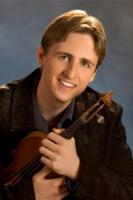|
Symphony
SRS SEASON ENDS WITH RESOUNDING TA-TA-TA-BANG
by Terry McNeill
Sunday, June 1, 2025
Symphony
YOUTHFUL VIRTUOSITY ON DISPLAY AT USO'S MAY CONCERTS
by Peter Lert
Saturday, May 17, 2025
Symphony
MYSTICAL PLANETS AND LIVELY GERSHWIN ORTIZ AT FINAL SRS CONCERT
by Peter Lert
Sunday, May 4, 2025
Symphony
VSO'S CONCERT MUSIC OF TIME, MUSIC OF PLACE
by Peter Lert
Sunday, April 27, 2025
Choral and Vocal
VOCAL ELEGANCE AND FIRE AT THE 222'S RECITAL APRIL 26
by Pamela Hicks Gailey
Saturday, April 26, 2025
CANTIAMO SONOMA SINGS AN INSPIRED GOOD FRIDAY MOZART REQUIEM CONCERT
by Pamela Hicks Gailey
Friday, April 18, 2025
DRAMATIC SHOSTAKOVICH SYMPHONY CLOSES PHILHARMONIC'S 25TH SEASON
by Terry McNeill
Sunday, April 13, 2025
LARGE COLLEGE OF MARIN AUDIENCE GREETS STOPHER ARTISTRY
by Terry McNeill
Saturday, April 5, 2025
Chamber
FRISSON DELIVERS SHIVERS OF DELIGHT
by Abby Wasserman
Sunday, March 30, 2025
OLD AND MOSTLY NEW IN SRS MARCH CONCERT IN WEILL
by Peter Lert
Saturday, March 22, 2025
|
 |
 Violinist David McCarroll |
HEROISM AND SUBTLETY IN ALL-BEETHOVEN MMF CONCERT
by Paula Mulligan
Wednesday, July 20, 2016
Much of the emphasis of this year’s Mendocino Music Festival has been about Beethoven, and a series of small venue performances with Beethoven lectures by Festival co-director Susan Waterfall preceded the July 20 orchestra performance in the big tent on Mendocino’s main street.
From the opening bars of the composer’s D Major (Op. 61) Violin Concerto it was apparent that the orchestra was well prepared. The exposition was played with clean attacks, precision and wonderfully shaped dynamics. The strong punctuations of timpanist Tyler Mack and short, incisive string chords contrasted beautifully with the lyrical threads that are so much at the heart of Beethoven, and part of his innovation as a composer.
After a long orchestral introduction the entrance of violinist David McCarroll had an indescribable sweetness, never saccharine, but with exquisite purity of tone. Mr. McCarroll plays with elegance and great depth, as well as a flawless technique that allows him to express what he feels in the music from 1806.
Near the end of the first movement it was startling to hear an altogether different cadenza from what one usually hears, and percussion playing was part of the cadenza, joining the violin solo in a way that was utterly new to me. Research revealed that it had been the cadenza used in the piano version of this piece in which Beethoven himself was the soloist, and is rarely performed. Mr. Mack’s playing was a crucial component of this work and he played with exquisite precision as Mr. McCarroll demonstrated his virtuosity and musicality.
The second Larghetto movement, dreamy and lyrical, found the woodwinds providing support and melodic lines of their own, and flowed beautifully. Near the movement’s end another short transitional cadenza lead into the whimsical theme of the last movement, and showed the humor that generated quite audible audience chuckles. It was a thoroughly delightful performance. Conductor Alan Pollack drew from the orchestra sensitive support for the soloist and never covered his most tender pianissimos. Mr. McCarroll, while brilliant with the bow, did not depend on brilliance alone, but on the sweet and understated expression that left many of the 500 in the audience leaning forward in their seats to catch every subtle nuance.
The E-Flat Major Symphony (Eroica), Op. 55, came at a turning point in Beethoven’s tumultuous life, and the two strong chords at the opening of the Allegro con Brio showed the precision and incisiveness that Mr. Pollack extracted from the Festival orchestra. Nothing tentative here, whether it is in the suppressed excitement of a barely audible pianissimo or the buildup to yet another crescendo. It is an exciting work that requires orchestral virtuosity from every section. The conductor paid minute attention to details that make the difference between a competent performance and one that is truly musical, with each phrase shaped and moving forward.
In the second movement, Marcia Funebre, the performance was contained and dignified with beautifully articulated strings, and a fine bass section that lead into each phrase with an unusual flourish in lower registers. Within this movement there are still contrasts, with the woodwinds providing well executed counter melodies. The Scherzo began softly, and once again passages in pianissimo retained rhythmic vitality that kept the music moving and evolving while retaining a sprightly and humorous feel.
The Finale opened with a spectacular downhill run in the strings that resolved into a pizzicato passage with the woodwinds. As the theme turned into a fugue, each line remained clear and uncluttered, having a balanced value and weight. The brass playing shone in a mighty climax. Elegant arpeggios from clarinetist Eric Kritz framed a return to a more restful theme, and brass sections leaders Bill Klingelhoffer (horn) and Scott Macomber (trumpet) brought another buildup to sonorous peak before the music dropped back to calm. This movement was a wild but wonderful roller-coaster ride with the opening theme restated before a release of tension in a famous and oft repeated sequence of tonic/dominant /tonic ending that is one of this composer’s trademarks.
In a pre-concert event Marin County lecturer Kayleen Asbo spoke of musical alchemy, spirituality and the Gospel of Thomas.
|
